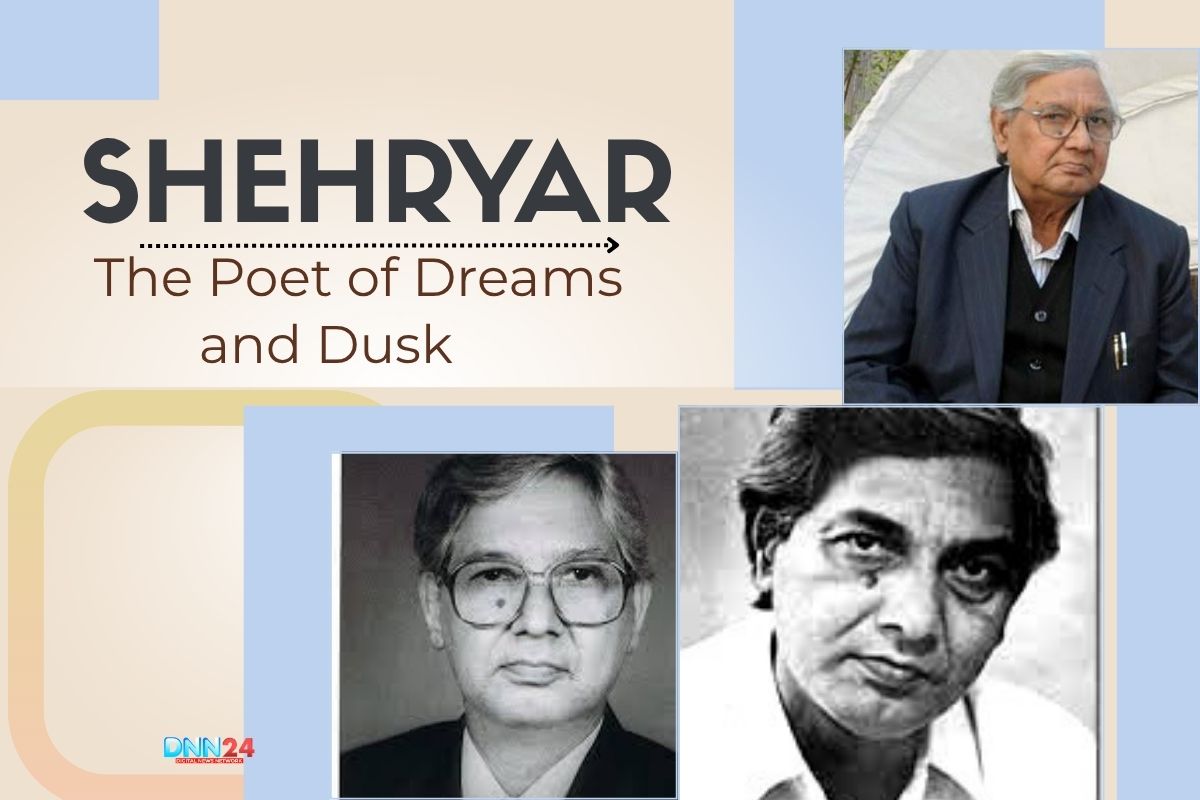Shehryar, a name that glimmers like a lone star in the vast sky of Urdu poetry, is not just a poet but a storyteller of the soul. His poems are calm streams that run through rivers and valleys of our souls, spreading the aroma of love, loss, and yearning. Born as Akhlaq Mohammad Khan in 1936 in Aonla, Uttar Pradesh, Shehryar’s journey from a small town to the grand stages of literature is nothing short of a poetic saga.
His pen name, ‘Shehryar’, means ‘friend of the city’, but he became a friend to every heart that yearned for love or battled with pain. His poetry is not a mere collection of words, but a living, breathing being that speaks to the soul in the stillness of the night.
sine mein jalan aankhon mein tufan sa kyun hai
is shahr mein har shaKHs pareshan sa kyun hai
When Poetry Changed Its Direction
Shehryar’s childhood was woven with the threads of simplicity and struggle. His father was a police officer, and the family moved often, painting Shehryar’s childhood with many colours and shades. But even as a young boy, Shehryar was drawn to the world of words. His courtyard was under a neem tree, and he would be sitting there with his scribbling lines on pieces of paper, and in the realms of fantasy. The family was not affluent, but there was much, not money, but culture and values in this family.
zindagi jab bhi teri bazm mein lati hai hamein
ye zamin chand se behtar nazar aati hai hamein
Shehryar’s mother often sings him lullabies in Urdu, and his father recites Ghalib and Mir couplets. These childhood inspirations formed the poet in him and cultivated his passion towards words and rhythm. The flight, however, did not take place without difficulties. There were days when the family struggled to make ends meet, and Shehryar often went to bed hungry. However, in those bad nights, he sought consolation in poetry and dreamt of a world where words could heal and connect.
ye kya jagah hai dosto ye kaun sa dayar hai
had-e-nigah tak jahan ghubar hi ghubar hai
The Unheard Tale: Shehryar and the Lost Manuscript
One of the most fascinating and untold stories of Shehryar’s life is about his lost manuscript. In his college days at Aligarh Muslim University, Shehryar wrote a collection of poems he considered his finest work. He would put the manuscript in a wooden box under his bed. Fate, however, decreed otherwise. One night, a robber broke into his hostel. The thief, looking around for valuables, took the box, which might contain money or jewellery.
justuju jis ki thi us ko to na paya hum ne
is bahane se magar dekh li duniya hum ne
However, in place of that, he only got pages of poetry. The next morning, Shehryar was heartbroken. Instead of despair, he was inspired. He composed a poem concerning the thief, assuming that the thief might be reading the poems under a street lamp, even getting relief in the verses. This incident became a turning point in Shehryar’s life, teaching him that poetry, like love, cannot be locked away—it must be shared, even with strangers.
zindagi jaisi tawaqqo thi nahin kuchh kam hai
har ghaDi hota hai ehsas kahin kuchh kam hai
Love, Loss, and Longing: The Heartbeat of Shehryar’s Poetry
Shehryar’s poetry is a mirror to his soul—tender, vulnerable, and deeply emotional. His most popular ghazal, which was forever immortalised by his film, Gaman, is not a song but a heartfelt cry. It is Seene Mein Jalan, Aankhon Mein Toofan Sa Kyun Hai. It sings of the hurt of loss, the twinge of dreamless dreams, and the continuity of the quest for identity. Shehryar’s words can make the reader pause, reflect, and sometimes, weep.
dil chiz kya hai aap meri jaan lijiye
bas ek bar mera kaha man lijiye
He wrote about not only love but also the loneliness that follows and the silence that remains when the loved one is away. But in his poems, he always finds some hope. There is always a promise that no matter how bad the night, a dawn is going to come. His poetry is equivalent to a lamp in the window, leading lost persons home.
siyah raat nahin leti nam Dhalne ka
yahi to waqt hai suraj tere nikalne ka
Untold Anecdotes: The poem and the Pigeon
There is a delightful story from Shehryar’s later years that few people know. Shehryar often sat by his window in his Aligarh home, watching pigeons flutter about. One day, one injured pigeon perched upon his sill. Shehryar, with his gentle heart, nursed the bird back to health. And he would speak to the pigeon, saying his new verses to it, as though he expected it to praise them. In its turn, the pigeon would coo very softly, as though it were acknowledging the poet’s words.
in aankhon ki masti ke mastane hazaron hain
in aankhon se wabasta afsane hazaron hain
This innocent friendship became one of his lesser-known poems in which he penned down his girlfriend, seeking companionship in unusual quarters. As a motive in his poems, Pigeon acted as a symbol of hope and healing and reminded him that it is possible to go between worlds and close the gap between a man and a bird, or perhaps even a poet and a reader.
dil mein rakhta hai na palkon pe biThata hai mujhe
phir bhi ek shaKHs mein kya kya nazar aata hai mujhe
The Legacy of Shehryar: Living Through Poetry
Shehryar’s life was a tapestry of stories—some heard, some unheard, some whispered in the quiet corners of his poetry. Instead of fame or fortune, he only wanted to affect the hearts and heal the wounds with his words. Even after winning the Jnanpith Award, the highest literary honour in India, Shehryar remained humble, always attributing his success to the love of his readers.
‘ajib saneha mujh par guzar gaya yaro
main apne sae se kal raat Dar gaya yaro
He thought poetry was an art and a duty- to make the unhearing listen, heal those in pain, and guide those at this crossroad. His memory breathes in all the lines, all the stanzas, and all the hearts, which are made stronger by his words. Shehryar may have left this world in 2012, but his poetry continues to sing—an eternal song of love, hope, and humanity.
Also Read: Sword, Soul, and Shayari: The Immortal Flame of Khwaja Haider Ali Atish
You can connect with DNN24 on Facebook, Twitter, and Instagram and subscribe to our YouTube channel.

